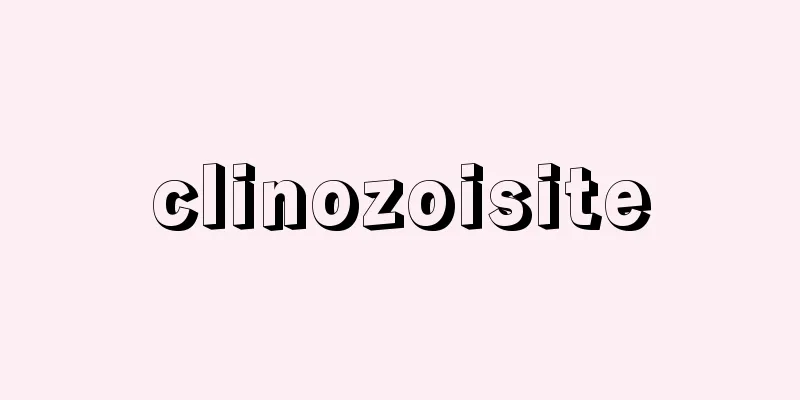Echinoderm - Echinoderm

|
A group of animals that make up a phylum, the highest classification in the animal kingdom. Existing species include five classes: crinoids, sea cucumbers, starfish, sea urchins, and brittle stars. They originated anciently, appearing in the Cambrian period at the beginning of the Paleozoic era, and crinoids and their fossil groups flourished during the Paleozoic era. They declined somewhat from the end of the Paleozoic era to the early Mesozoic era, but have continued to thrive in the world's oceans from the Jurassic period to the present day. The name echinoderm comes from the Greek word echino-derma, meaning one with skin like a hedgehog. Although many echinoderms do indeed have spines, as the name suggests, spines are not a defining feature of this group of animals. The essential characteristics of echinoderms are: (1) their external shape and the arrangement of their organs are radially symmetrical in five directions, (2) they have numerous calcareous bony plates beneath their epidermis, and (3) they have numerous elastic tubes called tube feet on their body surface, which are connected to a water vascular system inside their bodies made of a thin membrane. The ecological characteristics of echinoderms reflect their physical characteristics well. Radial symmetry is originally a plant-like physical structure, and the basic principle is to wait for food while remaining still in a fixed position relative to the space above and below. Stem-shaped sea lilies are the most typical example, with a plant-like appearance and a sessile lifestyle. Sea cucumbers and some sea urchins are exceptional in that they have a front-to-back orientation, but their internal body structure shows traces of pentaradial symmetry and their body movements are extremely slow. The subcutaneous bony plates make the echinoderm's body hard and are effective in protecting it from enemies, but they also increase its weight and slow its movements. In sea urchins, the bony plates are gathered together and glued together to form a shell, but in sea cucumbers, they have regressed to tiny bone fragments that can only be seen under a microscope. The spines are of the same origin as the bony plates, and in sea urchins, each one can be moved. Some sea urchins and starfish also have small, tweezers-like structures that open and close, called pedicels, which they use to ward off predators and clean the surface of their bodies. Tube feet are the most important organs that allow echinoderms to live like animals, and are used for a variety of purposes, including movement, feeding, breathing, and sensation. Most sea urchins, starfish, and sea cucumbers use tube feet to move, and these species have suckers at the tips of their tube feet. All use tube feet for feeding and breathing, but in sea cucumbers, the tube feet around the mouth become large peristaltic tentacles that are dedicated to feeding, and in some sea urchins, the tube feet on the top of the shell become flower-patterned gills that are dedicated to breathing. The internal organ system of echinoderms consists of the digestive, water vessels, blood sinuses, nervous and reproductive systems. The water vessel system is well developed in all groups, and in particular in those with suckers on the tube feet, the internal part of the body becomes a large pouch called a sac, which regulates the water pressure in the tube foot cavity. The water vessel system is arranged in five radial directions and forms a ring around the mouth. It then passes through a single tube called the scutellaria, and in sea urchins and starfish, it reaches a sieve-like plate called the scutellaria, which connects to the outside world. The arrangement of the blood sinus system and nervous system is also similar to that of the water vessel system. There is no heart or large ganglia. The blood sinus system is attached to an axial organ made of glandular tissue. The gonads are arranged in five radial directions, alternating with the water vessel system. Most species are dioecious, but there are also monoecious ones, and some are known to be ovoviviparous or to have a brood rearing habit. Their developmental pattern is the same as that of vertebrates, and they are of the actinocephalic, deuterostomal, and enterocoelomic types. The larvae are bilaterally symmetrical and usually undergo metamorphosis after a planktonic life, but some develop directly into the benthic life. In relation to humans, the gonads of sea urchins and the body walls, digestive tracts, and gonads of sea cucumbers are used for food. On the other hand, starfish eat useful bivalve mollusks, and some sea urchins have poisonous glands in their spines, which cause severe pain and swelling when stung. [Michio Shigei] (Schlothem) Mesozoic Triassic period, crown length approx. 7.3 cm, from Braunschweig, Germany, photo/AIST Geological Survey of Japan (GSJ F7617) Encrinus liliformis (crinoid) Klein Mesozoic Jurassic Shell diameter: approx. 10cm Produced in Gloucestershire, England Photo: National Institute of Advanced Industrial Science and Technology Geological Survey of Japan (GSJ F7630) Clypeus proti (sea urchin) ©Yoshitaka Morikami "> Schematic diagram of the sea lily's body structure © Tadaaki Ohkata "> Schematic diagram of sea cucumber's body structure © Tadaaki Ohkata "> Schematic diagram of starfish body structure The figure shows a purple sea urchin © Tadaaki Okata"> Schematic diagram of sea urchin body structure Source: Shogakukan Encyclopedia Nipponica About Encyclopedia Nipponica Information | Legend |
|
動物界の分類上、最上位の階級である門を構成する動物の一群。現生の種類としては、ウミユリ類、ナマコ類、ヒトデ類、ウニ類、クモヒトデ類の5綱が含まれる。起源は古く、古生代初頭のカンブリア紀にすでに現れ、ウミユリ類と化石の諸群は古生代に大繁栄を遂げた。古生代末期から中生代前期にかけてはやや衰退するが、ジュラ紀より現在に至るまで、世界の海洋でなおよく繁栄を続けている。 棘皮動物の名は、ギリシア語のechino-derma(ハリネズミのような皮膚をもつものの意)に由来する。棘皮動物のなかには確かにその名のとおり、棘(とげ)をもつものが多いが、棘をもつことがこの動物群の特徴とはいえない。棘皮動物の本質的な特徴としては、(1)外形や器官の配列が5方向に放射相称であること、(2)表皮の下に多数の石灰質の骨板があること、(3)体表に管足という伸縮する多数の細管をもち、それが薄膜からなる体内の水管系につながっていること、の3点があげられる。 棘皮動物の生態的特徴は、その体制的特徴をよく反映している。放射相称というのは、元来植物的な体制であり、上下周囲の空間に対して定位置でじっとしたまま餌(えさ)を待つのが基本となる。有茎ウミユリ類はそのもっとも典型的な例で、植物そっくりの外観をして、固着生活を送る。ナマコやウニ類の一部のものは例外的に前後に方向性をもっているが、その体の内部構造には五放射相称制の名残(なごり)がみられ、体の移動はきわめて緩慢である。皮下の骨板については、棘皮動物の体を硬くし、敵から身を守るのに有効である一方、体重を大きくして体の動きを鈍くしている。骨板はウニ類の場合、集合して互いに接着し、全体が殻となっているが、ナマコ類の場合は退縮して顕微鏡下でなければ認められないほどの小骨片となっている。棘は骨板と同一起源のもので、ウニ類の場合は、その1本1本を動かすことができる。ウニ類とヒトデ類の一部のものは、さらに叉棘(さきょく)という開閉する小さなピンセット状のものをもち、外敵を防いだり、体表の清掃に用いる。管足は棘皮動物が動物らしく生きるうえでもっとも重要な器官で、体の移動、摂餌(せつじ)、呼吸、感覚など、いろいろな目的に使用される。管足を体の移動に用いるのはウニ類、ヒトデ類、ナマコ類の大半のもので、それらの種類では管足の先端に吸盤をもつ。摂餌と呼吸にはすべてのものが管足を用いるが、ナマコ類では口の周りの管足が摂餌専用の大きな周口触手となり、ウニ類の一部のものでは殻上面のものが呼吸専用の花紋えらとなっている。 棘皮動物の内臓器官系は、消化、水管、血洞、神経、生殖系からなっている。水管系はすべてのグループでよく発達していて、とくに管足に吸盤をもつものでは、その体内部分が壜嚢(びんのう)という大きな袋になり、管足腔(こう)内の水圧を調節している。水管系は五放射状に配列し、口の周りでは環状となる。さらに石管という1本の管を経て、ウニ類とヒトデ類の場合は多孔(たこう)板というふるい状の板に至り、外界に通じている。血洞系と神経系の配列も水管系に準じる。心臓や巨大神経節はない。血洞系には腺(せん)組織からなる軸器官が付属する。生殖巣は水管系と交互の位置に五放射状に配列する。雌雄異体のものが多いが、同体のものもあり、卵胎生のものや保育習性をもつものも知られている。発生様式は脊椎(せきつい)動物と同系統で、放射卵割(らんかつ)、新口(しんこう)動物、腸体腔(たいこう)動物群型をとる。幼生は左右相称形で、普通、浮遊生活を経たのち、変態して底生生活に入るが、直接発生するものもある。 なお、人間との関係としては、食用としてウニ類の生殖巣、ナマコ類の体壁、消化管、生殖巣が利用される。一方、ヒトデ類による有用二枚貝類の食害があり、ウニ類のなかには棘に毒腺をもち、それに刺されると痛みがひどく、膨れ上がる危険なものもいる。 [重井陸夫] (Schlothem) 中生代三畳紀 冠部の長さ約7.3cm ドイツ ブラウンシュワイク産写真/産業技術総合研究所地質調査総合センター(GSJ F7617)"> エンクリヌス・リリフォルミス(ウミユリ… Klein 中生代ジュラ紀 殻径約10cm イギリス グロスターシャー産写真/産業技術総合研究所地質調査総合センター(GSJ F7630)"> クリペウス・プロティ(ウニ) ©森上義孝"> ウミユリの体制模式図 ©大片忠明"> ナマコの体制模式図 ©大片忠明"> ヒトデの体制模式図 図はムラサキウニ©大片忠明"> ウニの体制模式図 出典 小学館 日本大百科全書(ニッポニカ)日本大百科全書(ニッポニカ)について 情報 | 凡例 |
>>: Arctic worm (echinoderm) - Arctic worm (English spelling) Echinoderes dujardinii
Recommend
Zeuxidia
...Small ones have a wingspan of about 6 cm, whil...
Dutch auction (English: Dutch auction)
...Auctions are a standard way of buying and sell...
Union Europeenne Démocrate Chrétienne
...On the other hand, in Latin America, Christian...
Kawaramakimono - Kawaramakimono
This is a general term for the historiographies ha...
TRT - Tea Recipe
Trademark Registration Treaty : An agreement on th...
Tubificidae
…They are sold as food for ornamental fish, but t...
Scheduling theory - Scheduling theory
For example, consider a factory where several diff...
Nikolay Konstantinovich Mihaylovskiy
A Russian Narodnik theorist. Born into a family o...
Physics of the Earth's Interior
…In 1945, he wrote a book called “Seismicity of t...
rattlesnake master
...Flowers from June to July. L. scariosa (L.) Wi...
Gentileschi, A.
…Italian painter. His real name was Orazio Lomi. ...
Tughluq Timur (English spelling)
In this situation, conservative Mongolians who op...
neutron capture
…As in other nuclear reactions, radioactive captu...
Astasia genus
…Some species of Euglena, such as E. gracilis Kle...
Prince Hoshikawa
Year of birth: Year of birth and death unknown. A ...


![Wachi [town] - Wachi](/upload/images/67cd42c0ba547.webp)




![Chikura [town] - Chikura](/upload/images/67cc2d461ceea.webp)

